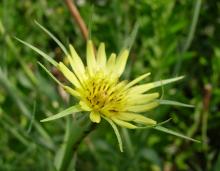Wildflowers, Grasses and Other Nonwoody Plants
Media

Species Types
Scientific Name
Asclepias incarnata
Description
Swamp milkweed has pink flower clusters at the tips of its tall stalks. The leaves are opposite, narrow, and up to 6 inches long. It grows in moist bottomland soils.
Media

Species Types
Scientific Name
Asclepias purpurascens
Description
The flowers of purple milkweed are pale purple to reddish purple to dark purple, with greenish or red tints. The scientific name means “becoming purple”: The flowers start off rather pale and become more intensely purplish as they mature.
Media

Species Types
Scientific Name
Lobelia siphilitica
Description
Blue cardinal flower, or blue lobelia, is a showy, late-blooming native wildflower that grows along streams, ditches, sloughs, and other wet places. It has blue or purple tubular flowers with 2 upper lips and 3 lower lips.
Media

Species Types
Scientific Name
Triodanis perfoliata (formerly Specularia perfoliata)
Description
Clasping Venus' looking glass is a single-stemmed plant with purple or blue star-shaped flowers and bluntly toothed, alternate leaves that clasp the stem. It's scattered statewide in a variety of habitats and blooms May-June.
Media

Species Types
Scientific Name
Apocynum cannabinum
Description
Indian hemp is a shrubby, upright perennial with opposite branches and milky sap. This native plant can be a troublesome weed in crop fields and gardens, but Native Americans used its tough, fibrous stems for rope-making.
Media

Species Types
Scientific Name
Amsonia illustris
Description
Often found on gravelly Ozark streamsides, shining blue star lifts its clusters of showy, light-blue flowers in late spring. A top choice for native wildflower gardening, it is interesting spring, summer, and fall.
Media

Species Types
Scientific Name
Euphorbia esula
Description
When you consider the negative effects this plant has on natural habitats, and how hard it is to control or eradicate, you almost want to rename it “leafy scourge”! This invasive plant is spreading in our state. Learn how to identify it.
Media

Species Types
Scientific Name
Pyrrhopappus carolinianus
Description
One of several native plants called dandelions, Carolina false dandelion is an annual with sulphur yellow flowers and puffy seedheads.
Media

Species Types
Scientific Name
Krigia biflora
Description
There are several members of the aster family that look something like common dandelions. But unlike the familiar lawn weed, two-flowered Cynthia is a native Missouri wildflower.
Media

Species Types
Scientific Name
Tragopogon dubius
Description
With its yellow composite flowers and round seedheads of fluffy “parachutes,” goat’s beard looks like a gigantic dandelion. A native of Europe, many people view it as an invasive weed.
See Also
About Wildflowers, Grasses and Other Nonwoody Plants in Missouri
A very simple way of thinking about the green world is to divide the vascular plants into two groups: woody and nonwoody (or herbaceous). But this is an artificial division; many plant families include some species that are woody and some that are not. The diversity of nonwoody vascular plants is staggering! Think of all the ferns, grasses, sedges, lilies, peas, sunflowers, nightshades, milkweeds, mustards, mints, and mallows — weeds and wildflowers — and many more!





















